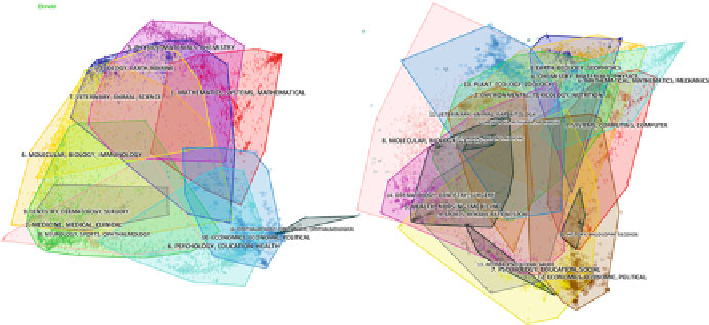Information Technology Reference
In-Depth Information
Fig. 8.25
The Blondel clusters in the citing journal map (
left
) and the cited journal map (
right
).
The overlapping polygons suggest that the spatial layout and the membership of clusters still
contain a considerable amount of uncertainty. Metrics calculated based on the coordinates need
to take the uncertainty into account
for each matrix. In this example, clusters are obtained by applying the Blondel
clustering algorithm. Figure
8.25
is a screenshot of the dual-map display, containing
a base map of citing journals (left) and a base map of cited journals (right).
For each journal in the citing network, its cluster membership is stored with
the journal along with its coordinates. The coordinates may be obtained from a
network visualization program such as VOSViewer, Gephi, or Pajek. Members of
each cluster are painted in the map with the same color.
A number of overlays can be added to the dual-map base. Each overlay requires
a set of bibliographic records that contain citation information, i.e. like the records
retrieved from the Web of Science. The smallest set may contain a single article.
There is no limit to the size of the largest set. With journal overlay maps, each
citation instance is represented by an arc from its source journal in the citing base
map to its target journal on the cited base map. Arcs from the same set are displayed
in the same color chosen by the user so that citation patterns from distinct sets can
be distinguished by their unique colors.
Figure
8.26
shows a dual-map display of citations found in publications of two
iSchools between 2003 and 2012. The citation arcs made by the iSchool at Drexel
University are colored in blue, whereas the arcs made by the School of Information
Studies at Syracuse are in magenta. At a glance, the blue arcs on the upper part of
the map suggest that Drexel researchers published in these areas, whereas Syracuse
researchers made few publications in these areas. The dual-map overlay shows that
Drexel researchers not only published in the areas that correspond to mathematics
and systems journals, Drexel researchers' publications in journals in other areas are
also influenced by journals related to systems, computing, and mathematics. The
overlapping arcs in the lower half of the map indicate that the two institutions share
their core journals in terms of where they publish.

Search WWH ::

Custom Search